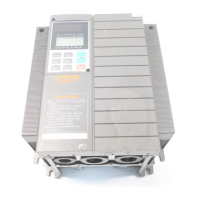5-32
External braking resistor
Standard Models
The braking resistor is protected from overheating by a thermal relay incorporated in the braking
resistor. Assign "Enable external alarm trip" THR to one of the inverter’s digital input terminals [X1],
[X2], [X3], [FWD], and [REV], and connect it to the terminals 2 and 1 of the braking resistor.
If you choose not to use the thermal relay incorporated in the braking resistor, set up the overheat
protection device using the values given in the table below.
Continuous braking
(Braking torque:
100%)
Repetitive braking
(Period: 100 sec. or
less)
Power
supply
voltage
Inverter type
Braking
resistor
type
Q'ty
Resis-
tance
(Ω)
Ca-
pac-
ity
(W)
Discharg-
ing
capability
(kWs)
Braking
time
(s)
Allowable
average
loss
(kW)
Duty
cycle
(%ED)
FRN0.4C1
-2
9 0.044 22
FRN0.75C1
-2
DB0.75-2
100 200
17 0.068 18
FRN1.5C1
-2
**
34
45
0.075 10
FRN2.2C1
-2
**
DB2.2-2
40
33 30 0.077 7
Three-
phase
200 V
FRN3.7C1
-2
**
DB3.7-2
33
400
37 20 0.093 5
FRN0.4C1
-4
9 0.044 22
FRN0.75C1
-4
DB0.75-4
200 200
17 0.068 18
FRN1.5C1
-4
**
34
45
0.075 10
FRN2.2C1
-4
**
DB2.2-4
160
33 30 0.077 7
Three-
phase
400 V
FRN3.7C1
-4
**
FRN4.0C1
-4
**
DB3.7-4
130
400
37 20 0.093 5
FRN0.4C1
-7
9 0.044 22
FRN0.75C1
-7
DB0.75-2
100 200
17 0.068 18
FRN1.5C1
-7
34
45
0.075 10
Single-
phase
200 V
FRN2.2C1
-7
DB2.2-2
40 400
33 30 0.077 7
FRN0.4C1
-6
9 0.044 22
Single-
phase
100 V
FRN0.75C1
-6
DB0.75-2
1
100 200
17
45
0.068 18
Note 1) A box (
) in the above table replaces S or E depending on the enclosure.
2) A box (
) in the above table replaces A, C, E, or J depending on the shipping destination.
3) Asterisks (**) in the above table denote the following:
21: Braking resistor built-in type, None: Standard

